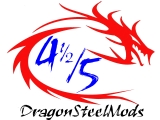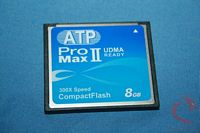Flash memory storage capacities are
growing, while the prices have dramatically decreased. What once
cost several hundred dollars can now be had for under one hundred
bucks. Still it is important to use quality flash memory; otherwise
those precious memories may quickly become fleeting memories.
Today we will look at the top of the
line Compact Flash card from ATP – the Promax II. Established in
1991, ATP has over 17 years of experience in the design, manufacture,
and support of high performance, highest quality DRAM modules and
NAND flash storage products. These cards feature the fastest write
transfer speeds available making them great for digital SLR camera
use. In addition they have write transfer speeds of 30 MB/Sec.
Today we will compare this Compact
Flash card against some worth competitors. So let’s take a better
look at the ATP ProMax II CF 8GB.
Reviewed by: Tomas Ratas
Sponsor: ATP
Tech Specs,Features or the
Basic Info:
ATP Part Numbers: AF1GCFP2,
AF2GCFP2, AF4GCFP2, AF8GCFP2
Capacities: 1GB to 8GB
Transfer Speed: Up to 45MB/sec
Read Speed (UDMA mode), Up to 30MB/sec Write Speed (UDMA mode)
Connector Pin: 50 Pins
Durability Water Resistant: Yes
Dust Proof: Yes ESD Proof: Yes Extreme Temp: Yes
Electrical characteristics: Supply
voltage CF: 3.0V-3.2V or 4.5V-5.5V
Environmental Characteristics:
Operating Temp: -25C to 85C
Storage Temp: -40C to 85C
Humidity: 8 – 95 % non-condensing
Vibration: 15Gs peak-to-peak Max
Shock: 2000G
Altitude: 80,000 ft Max.
Reliability Number of insertions:
10,000 minimum
Data retention: 10 years
Endurance: >100,000 cycles
(read/write and erase)
Physical characteristics: Length:
36.4mm Width: 42.8mm Thickness: 3.3mm
Weight: 9 g typical
Warranty: 5 Year Limited
By utilizing best in industry
components together with ATP tuned configurations, ProMaxII cards are
specifically made for those users looking for the fastest write
transfer speeds available. ProMax II CF cards take advantage of the
UDMA interface reaching a read speed of up to 300X or 45MB/sec! All
ProMaxII cards also allow for write transfer speeds at up to
30MB/sec, maximizing the potential for DSLR cameras and HD
camcorders.
* SLR Digital Cameras
* Point and Shoot Digital
Cameras
* Digital Camcorders
* Data storage
* PDAs and handhelds
* Global Positioning System
(GPS)
* Smart Phones
ProMax II CompactFlash cards are
also all built with ATP SIP technology, allowing for water, ESD, and
dustproof durability. These durability features, combined with the
highest performance, make them the perfect choice for professional
photographers who demand the highest quality from their memory.
A Better Look at Things
:
The packaging is pretty standard: a
clear plastic blister card with the flash drive mounted on the front
and a cardboard containing the product info behind it. On the front
there is the ATP and ProMax II logos and icons for Extreme
Temperatures, Waterproof, High Speed and HD Memory and the speed of
the CF card is listed as 300X (45 MB/sec).
The back has a listing of picture, song
and video storage capacity for the various size ProMax II cards along
with some specifications about the product.
Thankfully, ATP made this blister card
a pull open version. Kudos for that, don’t have to worry about
cutting your hands on sharp plastic! Inside the package we find the
CF card and a protective plastic case.
The ATP ProMax II looks like every
other Compact Flash Card on the market and features a blue label with
the name and ATP logo on the front. UDMA Ready and 300X speed is
also indicated.
The back is white with a couple of
lines and space for labeling the card.
Installation, Testing and
Comparison:
For benchmarking, I used SiSoftware
Sandra Professional Business XI and HD
TachRW. I pitted the ATP ProMax II CF 8GB against the
Kingston
CompactFlash Ultimate 266X 4GB Compact Flash Memory Card and the Sandisk Ultra II 2 GB for
comparison. To test transfer speeds, I used the Kingston
19-in-1 Card Reader.
The Removable Storage Benchmark using
Sandra Professional Business XI, shows the the Kingston CF Ultimate
266X 4GB running 8786 operations per minute, while the ATP ProMax II
CF 8GB came in at 7527 operations per minute and the Sandisk Ultra II
2 GB ran 3320 operations per minute.
Using HD TachRW and running the quick
bench, long bench and full bench options with writing enabled, the
ATP ProMax II CF 8GB fared better against the competition with burst
speed of 31 MB/s, average read speeds of 30.8 MB/s and average write
speeds of 25.9 MB/s. This matched the Kingston 266X 4GB which had a
burst speed of 31 MB/s, average read speeds of 30 MB/s and average
write speeds of 26 MB/s
The Sandisk Ultra II 2 GB did not
compare as well with burst speed of 11.9 MB/s, average read speeds of
12 MB/s and average write speeds of 9 MB/s.
Having the burst and write speed being
equal is critical to capturing fast moving data such as multiple
photographic action shots. Now benchmarking is all well and good,
but I like to see how the card works in the real world setting, I
loaded the card into my Canon XTi/EOS 400D and fired off a few dozen
shots. Here are a few action shots using the continuous shooting
mode.
The thing that sets the ATP ProMax II
apart from the competition is the UDMA support which allows for a
300X (45MB/sec) data transfer speed in devices requiring fast speeds
such as DSLR cameras. Unfortunately my Canon XTi does not support
the UDMA protocol, so the maximum speed gains were not achievable.
Newer digital cameras should take advantage of this technology.
Because the Kingston 19-in-1 Reader is
not UDMA enabled, the ATP’s speed advantage can not manifest
itself. In fact it is equal to the Kingston 266X for the most part.
Another important selling point about
the ATP ProMax II, it is designed to work in extreme environmental
conditions such as temperatures ranging from -25C to 85C, humidity of
8-95%, altitudes of 80,000 ft and shocks of up to 2000G. Now getting
a camera or other equipment to function under these conditions may be
another story.
Summary:
The ATP ProMax II is not the cheapest
card on the market, but it does offer certain advantages over its
competitors with UDMA support for quicker write speeds within Digital
SLR cameras and the ability to withstand some of the harshest
environments known to man. As UDMA enabled devices become more
prevalent, then this card will be the one to get. However, if you do
not have a UDMA enabled device, then the speeds of this Compact Flash
card is comparable to cheaper high speed cards and you might be
better off saving some money.
DragonSteelMods gives the ProMax II CF
a 4.5 out of 5 score.

Pros:
-Large Capacity
-Fast read/writes
-Works with DSLR, Video Cameras, GPS
Devices
Cons:
-Price
I would like to thank ATP for the chance to review the ProMax
II CF and for their continued support of DSM.
review# 537





















